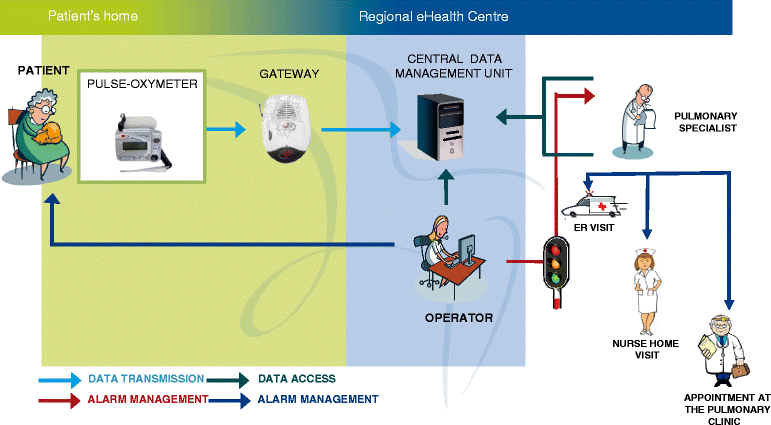Home telemonitoring for patients with acute exacerbation of chronic obstructive pulmonary disease: a randomized controlled trial
- PMID: 27876029
- PMCID: PMC5118881
- DOI: 10.1186/s12890-016-0321-2
Home telemonitoring for patients with acute exacerbation of chronic obstructive pulmonary disease: a randomized controlled trial
Abstract
Background: Although a number of studies have suggested that the use of Telemonitoring (TM) in patients with Chronic Obstructive Pulmonary Disease (COPD) can be useful and efficacious, its real utility in detecting Acute Exacerbation (AE) signaling the need for prompt treatment is not entirely clear. The current study aimed to investigate the benefits of a TM system in managing AE in advanced-stage COPD patients to improve their Health-Related Quality of Life (HRQL) and to reduce utilization of healthcare services.
Methods: A 12-month Randomised Controlled Trial (RCT) was conducted in the Veneto region (Italy). Adult patients diagnosed with Class III-IV COPD in accordance with the Global Initiative for Chronic Obstructive Lung Disease (GOLD) classification were recruited and provided a TM system to alert the clinical staff via a trained operator whenever variations in respiratory parameters fell beyond the individual's normal range. The study's primary endpoint was HRQL, measured by the Italian version of the two Short Form 36-item Health Survey (SF36v2). Its secondary endpoints were: scores on the Hospital Anxiety and Depression Scale (HADS); the number and duration of hospitalizations; the number of readmissions; the number of appointments with a pulmonary specialist; the number of visits to the emergency department; and the number of deaths.
Results: Three hundred thirty-four patients were enrolled and randomized into two groups for a 1 year period. At its conclusion, changes in the SF36 Physical and Mental Component Summary scores did not significantly differ between the TM and control groups [(-2.07 (8.98) vs -1.91 (7.75); p = 0.889 and -1.08 (11.30) vs -1.92 (10.92); p = 0.5754, respectively]. Variations in HADS were not significantly different between the two groups [0.85 (3.68) vs 0.62 (3.6); p = 0.65 and 0.50 (4.3) vs 0.72 (4.5); p = 0.71]. The hospitalization rate for AECOPD and/or for any cause was not significantly different in the two groups [IRR = 0.89 (95% CI 0.79-1,04); p = 0.16 and IRR = 0.91 (95% CI 0,75 - 1.04); p = 0.16, respectively]. The readmission rate for AECOPD and/or any cause was, however, significantly lower in the TM group with respect to the control one [IRR = 0.43 (95% CI 0.19-0.98); p = 0.01 and 0.46 (95% CI 0.24-0.89); p = 0.01, respectively].
Conclusion: Study results showed that in areas where medical services are well established, TM does not significantly improve HRQL in patients with COPD who develop AE. Although not effective in reducing hospitalizations, TM can nevertheless facilitate continuity of care during hospital-to-home transition by reducing the need for early readmission.
Trial registration: Retrospectively registered on January 2012, ClinicalTrials.gov Identifier: NCT01513980 .
Keywords: Chronic obstructive pulmonary disease; Health-related quality of life; Hospitalization; Telemonitoring.
Figures
References
-
- Lozano R, Naghavi M, Foreman K, Lim S, Shibuya K, Aboyans V, et al. Global and regional mortality from 235 causes of death for 20 age groups in 1990 and 2010: a systematic analysis for the Global Burden of Disease Study 2010. Lancet. 2012;380:2095–128. doi: 10.1016/S0140-6736(12)61728-0. - DOI - PMC - PubMed
Publication types
MeSH terms
Associated data
LinkOut - more resources
Full Text Sources
Other Literature Sources
Medical



